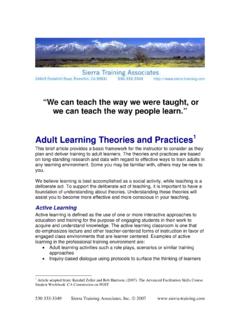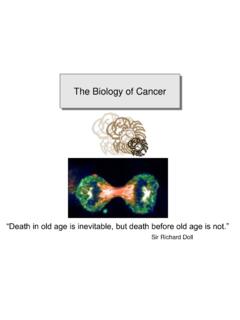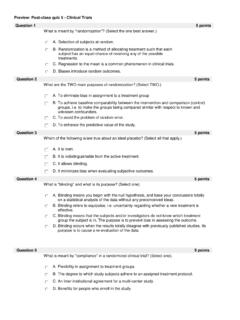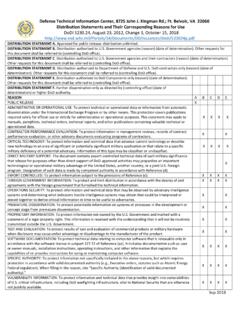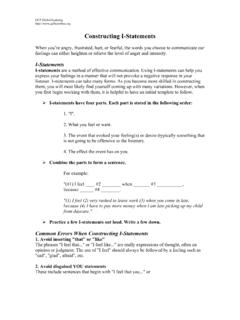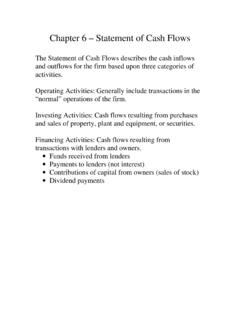Transcription of Writing outcome statements
1 Writing outcome statements "Outcomes - are specific, measurable statements that let you know when you have reached your goals. outcome statements describe specific changes in your knowledge, attitudes, skills, and behaviors you expect to occur as a result of your actions. Good outcome statements are specific, measurable, and realistic. ( Kellogg Foundation Logic Model Development Guide, available here: ) Think carefully about what you can realistically accomplish given the groups you want to reach and the scope of your resources. Develop outcomes as follows: Outcomes should describe what you want to happen after your activity is completed.
2 Focus your intermediate outcomes on what you want people to do when they go back to their [classes, workplaces, etc] and apply what they have learned. Impacts describe the impact you hope to have on your issue area after the trainings are completed, but farther into the future. Describe what you hope will change as a result of your activities. Well-written and complete outcome statements will usually define the following five elements (Fisher, Imm, Chinman & Wandersman, 2006) as you describe: Who will change - the [people] you are training What will change - the knowledge, attitudes, and skills you expect to change By how much - how much change you think you can realistically achieve By when - the timeframe within you hope to see change How the change will be measured - the surveys, tests, interviews, or other methods you will use to measure the different changes specified Writing output statements Outputs are the widgets , they are the trainings that you do or policies you write or products you develop.
3 Output statements help to identify process evaluation measures. Process measures document activities that take place during the initiative which help you determine how well things are going. Outputs can include many aspects of your initiative, such as: Members who participate: the number and type of participants, frequency of attendance, and turnover rate of the members. Example: At the last general meeting of the initiative, 17 people attended. Of these folks, 10 were regular members, and 7 were sitting in on a meeting for the first time. Services that are ultimately provided: classes, programs, workshops, coalitions or committees convened or other services provided for the community by the initiative.
4 Example: Nutrition education workshops were conducted by childcare providers. Products that are developed: publications, policies, educational materials or other products. Example: A sample policy was developed and approved by a group of community and content experts. Media coverage: by radio, television, and print media. Example: Several five minute radio spots describing one of your group's projects aired on a local FM radio station. Financial resources: grants or donations. Financial resources also can include "inkind" services, such as free advertising or products that an individual or business might offer instead of money.
5 Example: $8000 was received at a $50 per plate lunch that was held to raise money for local drug and alcohol abuse efforts. Community actions: actions taken to encourage change in the community. Example: Merchants were asked to display signs describing the penalty for selling alcohol to minors and the need for proper identification. ( ) Assumptions and things outside of our control Assumptions are beliefs we have about the program, the people involved, and how we think the program will operate. For Our assumptions might include: we can get/find the needed pills, that we will take the pills as prescribed, that the pills will lead to an improvement, and that we will not experience any negative side effects Speak the unspoken let s name the unnamed assumptions!
6 Can you identify 5 assumptions that you make about your current programming? External factors are aspects external to the program that influence the way the program operates, and are influenced by the program. Dynamic systems interactions include the cultural milieu, biophysical environment, economic structure, housing patterns, demographic makeup, family circumstances, values, political environment, background and experiences of participants, media, policies, priorities, etc. These are elements that affect the program over which there is little to no control. Can you identify 5 external factors that could impact both the outputs and outcomes of your logic model?
7 Headache (situation)Get pills (inputs/ resources)Take pills (outputs)Feel better ( outcome )Logic models: The why It s important to spend time understanding the situation you are trying to change, the existing priorities of the agency, and your program s priorities. The situation is the originating problem, or issue, set in a complex sociopolitical, environmental, and economic circumstance. For more info: - What situation are we working to address? - How do we know that it is a problem? - What is the current state of the problem? - Does our community view it as a problem? How do we know? - What is the audience we are hoping to reach?
8 What do we know about that audience? - What are relevant barriers and facilitators? Why use a Logic Model? Among their many functions, logic models are great for: Organizing a program evaluation Explaining a program evaluation Reflecting on and/or analyzing a program evaluation In program evaluations, logic models rely on the tight link between: Program goals Program Services Measurement plans Use a logic model to help generate the clarity and specificity required for success and often demanded by funders and constituents. Logic modeling offers an organized way of defining your program goals, services, and measurable outcomes by producing: An inventory of what you have and what you need to operate your program A strong case for how and why your program will produce desired results A method for program management and assessment Logic modeling can enhance a practitioner s ability to plan, design, implement, analyze, and generate knowledge.
9 The process of developing the model is an opportunity to chart the course. It is a conscious process that creates an explicit understanding of the challenges ahead, the resources available, and the timetable in which to hit the target. Additionally, it helps to focus on the big picture as well as the component parts. constructing a logic model should be part of an ongoing process of discussion, commitment, and reflection as part of an organization s dedication to program improvement and accountability. The logic model process serves as the starting point for this conversation and can later be considered the report card that you might use to understand whether or not you are meeting your program goals and objectives.
10 Logic models can be developed to meet large or small-scale outreach program goals. They should be revisited on regular basis and should closely reflect the goals of your program and evaluation plan. Finally, logic models can illustrate how prevention programs are part of the strategic and ongoing access, retention, and success conversation within an organization.
